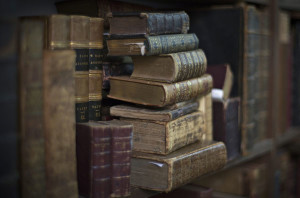December 2015
By Lewis Turco

I began to collect books as soon as I could read, and I enjoyed reading so much I very early decided I wanted to be a writer, to my parents’ sorrow, for they wanted me to be a preacher like my father. I was soon myself bent over the old manual typewriter he’d used to write sermons, hunting and pecking out short stories. In junior high I wrote articles and poems for the school paper, and in 1949, just before I entered high school, one of my short stories won a prize in a summertime high school fiction contest. It was published by the sponsor, a local newspaper in Meriden, Connecticut, where I grew up. I’d been a paperboy since I was in the fifth grade, and in high school I was clippings librarian (called the “morgue clerk”) and cub reporter for The Morning Record.
My seventh-grade shop teacher, John Houdlette of Lincoln Junior High School in Meriden, had a daughter, Jean, whom I’d noticed early on. In high school we were classmates and members of the same crowd. Some of the boys in that crowd started a science-fiction reading club called The Fantaseers, which supported a one-bookcase library at my house. In 2004, I published a book titled Fantaseers, A Book of Memories; there’s a photo of the Fantaseers’ library in it. By the time we graduated, of course, all those books were left behind and became part of my own collection. By the time Jean and I were married in 1956, I had books everywhere and no place to put them, so I brought a lot of them up to Jean’s family place in Dresden, Maine, adding them to the large collection that was already there. They were like snow: over the years they accumulated in drifts.
In 1960 I began teaching English literature and creative writing at Fenn College, now Cleveland State University, and since then I’ve written a great many book and chapbook manuscripts, more than 50 of which have appeared in print. However, it was a late colleague of mine at the State University of New York at Oswego, where I directed the Program in Writing Arts and taught for 31 years, who got me started as a bookseller. His name was David Winslow. He had a Ph.D. in folklore, but he had had several other careers as well, including selling antiques and books. He taught me what I know about books as a commodity when he and I, on weekends mostly, became what are known as “book scouts.” We’d sell the books we found upstate to downstate New York book dealers. And, of course, I also sold some of the books I’d been accumulating.
One day David called me up to say there was a big sale of stuff in Hannibal, not far from Oswego. They’d advertised books, but when we got there all we found was a box of paperbacks under one table. Dave sneered and walked away to look at other things, but I went through the paperbacks and found one, a first-edition paperback original titled My Hope for America by Lyndon Baines Johnson. I bought it for 10 cents.
When we got back to the car Dave saw I’d bought something, asked to see it, and then began to rag me about it. All I’d paid for it was a dime, but he acted as though I’d thrown away a fortune. By the time we got home I was furious and decided to wreak my revenge.
My mother had been good with handicrafts, and she’d taught me how to bind a book. In college I’d bound my paperback textbooks so they’d last longer, and as an adult I’d taken to binding paperbacks and restoring old books as a hobby. So I took the Johnson book, quarter-bound it in cloth and leather, put it in a package with an old leather-bound hymnal, and sent it with return postage to former President Lyndon Johnson. In an enclosed letter I asked him if he’d be willing to sign my book in exchange for the hymnal, which I hoped he would accept as a gift.
Not a great while after that, I got his book back. President Johnson had signed a Presidential bookplate for me, and he included a letter on official stationery telling me he was delighted with the hymnal, which he was going to place in the L. B. J. Presidential Library in Austin, Texas. I pasted the bookplate onto the inside front cover of My Hope for America, and I tipped his letter into the volume. Then I called David and asked him to come over so I could show him a book I’d picked up for ten cents at a lousy sale in Hannibal. Later on, I sold the book for a lot of money on one of our downstate book trips.
When Dave and I traveled to a dealer in Johnstown, New York, I was shown an old book with no cover page; it was missing some other pages as well. At the time, I was collecting books and doing research for a book manuscript I’d soon write titled Satan’s Scourge: A Narrative of the Age of Witchcraft in England and New England 1580-1697. I thought I recognized the volume the dealer was showing me, despite its lack of a title page, so I bought it for $25. When I got it home, I looked it up. Sure enough, it was a first-edition copy of A True and Faithful Relation of What Passed for Many Years Between Dr. John Dee and Some Spirits, etc., edited, with a preface, by Meric. Casaubon and published posthumously in London in 1659.
Dr. Dee was Royal Mathematician to Queen Elizabeth I, but he was also interested in spiritual matters. The book I’d found is one of the most famous occult books in the English language. It was a record of the conversations William Kelly, Dr. Dee’s con-man pal, had with “Madimi” and many other celestial beings, as he dictated them to the good Doctor who could see and hear nothing in the crystal Kelly used. Kelly came to a bad end. My wife and I saw Dr. Dee’s crystal ball–it was egg-shaped, really–in the British Museum while we were in England in 1993.
I wrote to the Cornell University Library, which has a great occult collection, and asked them to send me photocopies of the missing pages. I then restored it and hand-bound it in studded, leather-covered wooden boards in 1971. Many years later, after I’d finished my own book, begun the Mathom Bookshop in Dresden, and gone online, I sold that book to someone in Australia for $1,000.
During our summers in Maine I’d go out on bookfinding trips, sometimes alone, sometimes with Jean. Sometimes, her sister Nathalie would come along. One of the places we’d go was Frank McQuaid’s Book Barn in Edgecomb. He’d been a World War II bomber pilot, and I’d been a sailor during and after the Korean War. Another character who roped me into the bookselling business was Charlie Davis, still legendary in Oswego, New York, and in the worlds of folklore and jazz as well. He turned from music to business to poetry and fiction writing and editing.
We crossed paths when he took a course in poetry writing with the late Roger Dickinson-Brown, then a member of the staff of my Program in Writing Arts at SUNY Oswego.
Davis had grown up in Indiana. His father had been a close friend of a neighbor, James Whitcomb Riley, the “Hoosier Poet,” and Charlie early came under Riley’s benevolent influence. Later on, Charlie graduated from Notre Dame University and, upon his graduation, organized a group of musicians during the heyday of the Big Bands–he wrote about it in his book, That Band from Indiana–and was very successful on the swing and hot jazz circuits. Those of you who watched Ken Burns’s history of jazz on PBS may have noticed a marquee at the Brooklyn Theatre that read, “Charlie Davis and His Joy Gang,” which shared the billing with a young singer named Ethel Merman. Charlie’s band singer was another young person named Dick Powell. One of his compositions of the period was “Copenhagen,” a jazz classic that has been performed by nearly all the famous swing and jazz artists since it was introduced. The composer drew royalties from it twice a year until his death in his nineties.
The first course Davis took was titled “The Nature of Poetry.” It was a beginner’s course but stringent and technical. In it, the student must write verse exercises in every prosody, schema, and genre imaginable.
Davis did well for Dickinson-Brown, and he began to involve himself in the extensive literary scene on campus. He gave readings with other students, and his work was always popular because it was…quaint is the only word to describe it. The Riley influence was clear, at least to the faculty if not to the students, who’d never heard of the Hoosier Poet.
Davis’s next course was a graduate seminar titled “Conference Course in Writing Poetry.” I taught it. The project involved writing a long poem, something he’d never done, and he was (atypically for the class) given a proscription: He was not to write a single rhymed couplet. Instead, he was going to do something difficult–for him, that is.
“But what?” he asked, baffled.
“Well, have you ever heard of William Carlos Williams?”
“No, should I have?”
“Yes, since he’s a famous contemporary of yours. Your first assignment is to read Williams’s Paterson.”
Davis did so. No sooner had he digested the book than he began to write. Davis’s And So the Irish Built a Church is a story about Oswego written, like Paterson, in prose and verse, with diary entries, newspaper clippings, songs, and what-have-you (it is impossible for the reader to identify what Davis invented and what he researched), tossed together in a seemingly random, but for all that highly wrought, melange of lore and character and incident. Davis was so carried away he even composed a pseudo-19th-century musical piece and copied it out on aged paper suitably charred to look as though it had been saved from the conflagration that consumed the original church.
It turned out to be 120 pages in length–and popular. Everyone was interested in reading the next installment, though Charlie, doing something totally new and experimental for him (except where he managed to sneak in a rhymed song against orders), couldn’t believe his classmates were serious when they applauded him.
Since the publication of Charlie’s book, there have been people who know W. C. Williams who claim that …And so The Irish is more readable than its model. Since Paterson is a modern classic, this opinion is heretical. The main criticism of the Davis opus may be that it begins to a degree shakily. Riley is recognizable in the sentiment, and Williams in the form: the two do not mix well early on. But as the book progresses, Riley and Williams disappear and Davis rises above his sources to become one of the most engaging literary personalities of the late 20th century, just as the man himself was larger than life.
Well, when Charlie had finished, he told me he was too old to start sending his book around to publishers and wait for them to accept it. He thought he’d publish it himself. So he gave himself, with my kibitzing, a short course in book publishing. When The Irish appeared it soon sold out, inspiring Charlie to launch his final career as a publisher. He asked me for a name for the press. I suggested “Mathom.” I told him it was a word out of The Hobbit and Lord of the Rings that describes the sort of things that fill the burrow homes of Bilbo and Frodo Baggins: things one has no earthly use for but simply couldn’t bear to throw away. Charlie thought that accurately described the sorts of things he and I would publish (without asking, he assigned me as Editor-in-Chief of Mathom).
Two years later, in 1979, I established my summer project, the Mathom Bookshop and Bindery of Dresden Mills, Maine, which would be the North American outlet for the books we published. As though hearing about the shop, books from everywhere began to fly in. Among the Mathom titles were Oswego Charlie Davis’s The Lake Trout and Legend Society’s Cookbook, 1980, and the story of Charlie’s career as a musical director, That Band from Indiana, 1982. More recently, there’s my The Green Maces of Autumn, Voices in an Old Maine House, issued in 2002. It’s a series of monologues by the people who live in the 1754 house built by Sylvester Gardiner on the property where my wife’s family has lived for a century or two.
I opened my shop in the tractor garage of the farm on Blinn Hill Road, put a handmade sign out on the road, and began to sell some of the books. I started out with one short shelf of books. Pretty soon I added a shelf, and then another and another, and then I was building permanent bookshelves. One day the Maine State D.O.T. stopped by to tell me I needed to register my business with the sales tax office, and my signs had to conform to rules and regulations. Things were beginning to get expensive.
I sold my books cheaply. Customers would stop by, and when they’d bought what they wanted they’d tell my wife that I was charging too little for my collection. In 1995, I decided to salvage the barn. I put a new floor into the northwest corner where it had collapsed, then built a room on it with shelves, lighting, a phone, and other amenities. The next thing I did was move my books from the garage into the new bookshop, and while I was doing that, I decided to clean out my junk books and re-price everything.
One of the books I ran across while I was doing this was a beat-up loose-leaf black cloth notebook bound in half red leather and holding a set of printed pamphlets, 390 pp., constituting a course in Business Law taught at M.I.T. during the school year 1895-96. The pamphlets were in very good shape, but the binder was well worn and the spine was crumbling. It belonged to “C. B. Paine,” who apparently took the course during his “2nd year,” according to an ink notation on the rear pastedown. In the garage I’d had a sticker price on this item of ten cents.
There were two semesters’ worth of printed pamphlets in the binder, held in upside-down by short cords. The name of the teacher was on none of the first semester pamphlets, but on those of the second semester I found the instructor’s name: Louis D. Brandeis, later to become Chief Justice of the United States Supreme Court. His specialty was business law, and, indeed, he was teaching at M.I.T. in the pertinent years.
Obviously, I was no longer going to sell the binder and its contents for ten cents! But what price was I going to put on it? 1995 was the year when the Mathom Bookshop went online, so I warmed up the computer and looked in Bookfinder and everywhere else. There was no trace of another copy anywhere in the world. All I could do was shrug my shoulders and put an arbitrary price on the Brandeis item. I thought $800 sounded pretty good. As soon as Business Law appeared online, a Washington attorney snapped it up. At least my second price was better than my first!
It was never hard to find books to sell. Books found me.
❧
By the way, I have recently finished reading a book by one of my favorite authors, Umberto Eco. Titled The Mysterious Flame of Queen Loana, it is about an Italian rare books dealer who’s had a stroke. When he comes out of it, he remembers nothing of his actual life, only the books he’s read.





0 Comments